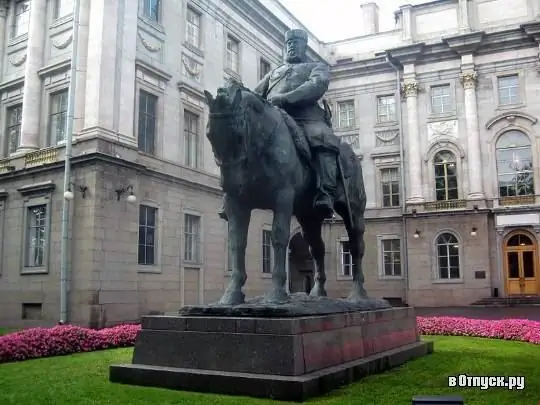
Description of the attraction
In 1994, in St. Lenin, on Znamenskaya Square, an equestrian statue of Emperor Alexander III was erected. This event was the return of the monument from its long "wanderings". Initially, the monument to the emperor was erected in the center of Znamenskaya Square. It was dedicated to Alexander III as the founder of the Trans-Siberian Railway, which began at the Nikolaevsky (Moskovsky) railway station located nearby.
The customer of the monument was the royal family and personally Nicholas II. Of the projects presented, preference was given to the work of the sculptor from Italy P. Trubetskoy. The statue of Alexander was made of bronze by the caster E. Sperati. It was cast in parts: the figure of the autocrat in Robecca's workshops, and the horse in the steel factory. The three-meter pedestal (architect F. O. Shekhtel) is made of red granite. It was inscribed: "To Emperor Alexander III the Sovereign Founder of the Great Siberian Way."
Work on the monument lasted from 1899 to 1909. For greater convenience, a special workshop was built on Staro-Nevsky Prospect. During the preparatory work, the sculptor Trubetskoy created 8 small models of the monument, 4 life-size and 2 full-size copies. The brother of Alexander III, Grand Duke Vladimir Alexandrovich, who saw one of these models, considered it a caricature and spoke unflattering about Trubetskoy's work. However, the Dowager Empress liked the work of the sculptor, as she saw in it a great portrait likeness.
The monument to Alexander III was different from other monuments to the autocrats. The sculptor depicted the emperor without any idealization and splendor. On a huge red marble parallelepiped, riding on a heavy draft horse, is depicted an obese man in baggy clothes and a lamb's hat, somewhat like a horse policeman, who rests with one hand on his thigh.
This monument clearly shows the creative credo of Trubetskoy, who believed that the portrait should not have an exact resemblance to a person, but should reflect his characteristic features. Trubetskoy is credited with the following phrase: "I depicted one animal on another." The monument caused discontent among the members of the royal family. Nicholas II even wanted to send him to Irkutsk. S. Yu. Witte, a contemporary of P. Trubetskoy, wrote that the sculptor was not invited to the grand opening. However, on May 23, 1909, in the presence of royal persons, the monument was opened and consecrated.
Reviews of the monument to Alexander in society were ambiguous and rather disapproving. The pedestal was compared to a chest of drawers, the horse - to a hippopotamus, and Alexander himself - to a goof.
After the October Revolution, the old inscription was knocked down from the pedestal of the monument and replaced with another one, the authorship of which belonged to the poet Demyan Bedny and was offensive to the autocracy in character, reflecting the trends of that time.
“… I am stuck here as a cast-iron scarecrow for the country, Ever thrown off the yoke of autocracy.
The penultimate autocrat of the All-Russian Alexander III.
During the celebration of the 10th anniversary of the October Revolution, it was used in decoration - it was closed in a metal cage, two masts with a hammer and sickle at the top, a wheel and a tower were attached next to it.
In 1937, the monument was dismantled and removed to the storerooms. After the Great Patriotic War, 3 stones were separated from the pedestal, which were used to make busts. In 1953, the monument was moved to the courtyard of the Russian Museum, and in the 80s the statue of a horse was hidden under a special cap. It was only in 1990 that the statue was freed from this hiding place.






